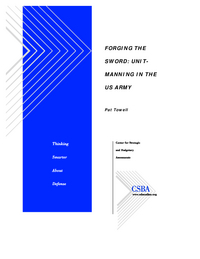
The Army’s plan for “Unit-Focused Stabilization”—organizing soldiers into combat units that would remain intact for about three years at a time—will implement an approach to personnel management that has been ardently promoted for decades both by some of the Service’s most distinguished general officers and by some of its most prominent internal critics. This approach, which is generally referred to as “unit manning,” marks a sharp departure from the Army’s practice during most of the 20th century. In the past, personnel were routinely moved in and out of combat units, even during major wars in Vietnam and Korea, according to the dictates of a system focused on developing the careers of individual soldiers by moving them though a variety of assignments rather than on maximizing the organizational stability of units.
The goal of the new approach is to stabilize personnel in combat units. According to proponents, greater stability will foster relationships of mutual confidence and loyalty among unit members that will make the unit more cohesive and thus better able to tolerate the psychological stress of battle. A complementary argument is that stabilization enhances combat effectiveness by allowing personnel to train together long enough to become more proficient in complex tactics that require collaboration among the unit’s members in addition to individual skill.
The argument that a closely knit “band of brothers” can whip a larger but less cohesive force is intuitively appealing and has been widely accepted in the Army and among civilian defense policy analysts, particularly since World War II. Indeed, in the mid-1980s, when the Army was conducting the COHORT (Cohesion, Operational Readiness, and Training) program—a previous effort to implement unit manning—a panel overseeing the program recommended that Army behavioral scientists not bother even trying to measure whether more cohesive units were, in fact, more resilient in battle.
So, in mandating a sweeping adoption of the unit-manning principle for combat formations, Army Chief of Staff Gen. Peter J. Schoomaker stands in distinguished company. Nevertheless, it is striking that this far-reaching change is being undertaken despite the fact that the benefits are unproven and the associated costs and tradeoffs are largely unexamined.
The argument for stabilization rests, in part, on beliefs about the relationship of personnel stability to the relative performance of US and German troops in World War II and to, to a lesser extent, to the supposed failings of US troops during the Korean and Vietnam wars.
This report offers an assessment of those historical cases. It also examines the COHORT program—the most ambitious of the Army’s earlier efforts to implement unit manning—to determine whether formations organized on that basis realized the promised improvements in cohesiveness and performance.



























